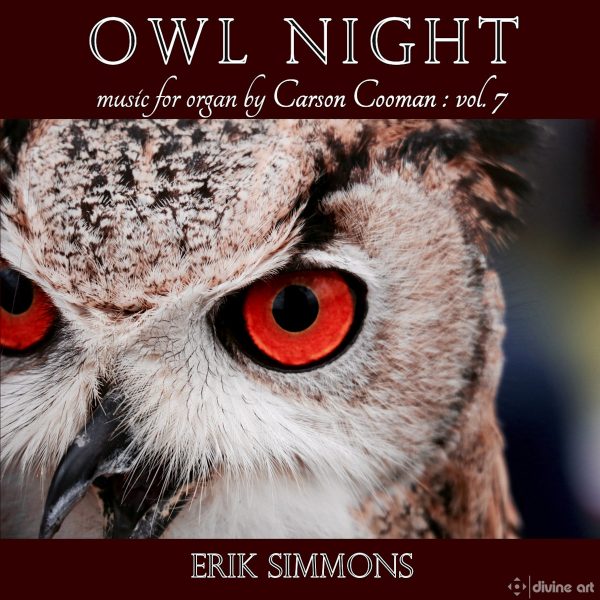Fanfare
This is now Volume 7 in Divine Art’s series of discs devoted to the organ works of the extraordinarily prolific Carson Cooman, who seems well on his way to challenging Telemann for the title of most prolific composer in history. I gave approving reviews to Volumes 4, 5, and 6 in issues 38:1, 41:2, and 41:4. This new volume is cut from much the same cloth as its predecessor. Most of the works are of short duration—the closing Toccata, Aria and Finale is an exception for Cooman in being 12:02 in length—and predominantly on the quiet, meditative end of the spectrum. Once again, various pieces were written for (or in memory of) or dedicated to various other organists—Felix Brauer, Eva-Maria Houben, Eberhard Kraus, Wolfram Graf, Lucca Massaglia, Raimund Schacher, Reiner Gaar, Dietrich Hopfner, Markus Nickel, Erich Koch, and Flemming Hansen—as well as non-organists (Burkhard and Petra Mohr, and in memory of Dorothy Virginia Garman Blankenship). The idiom is always tonal, though some selections are leavened with varying degrees of dissonance, with tracks 2, 6, 10, and 17 being the most pungent. The five preludios have consecutive opus numbers (1171 to 1175) and form a kind of miniature suite that is my favorite section of this disc.
Overall these works provide for pleasant if not memorable listening. I will confess to finding one work, the second of the Two Mantras (track 2), intensely irritating due to its monotonous use of a rapidly pulsating figuration *, and I also was not particularly taken with the closing Chorale of the Concerto piccolo (track 6), from which readers would rightly infer that Cooman’s spikier works are less to my taste.
As usual, Eric Simmons is an able advocate for the composer, and is well recorded. As with the previous disc, Hauptwerk software is used for remote access to the organ actually heard, in this instance the Cavaille-Coll instrument of the Abbey of Saint-Etienne in Caen, France. Cooman’s brief booklet notes mostly provide basic data regarding his compositions (title, opus number, date, dedicatee) and a one-sentence characterization. As before, cordially recommended to the composer’s fans.
* note from divine art: the reviewer is referring to a piece called ‘mantra’ inspired by the religious/meditational chanting of that name – which by its very nature is a repetitive pulsing figure……
@divineartrecordingsgroup
A First Inversion Company
Registered Office:
176-178 Pontefract Road, Cudworth, Barnsley S72 8BE
+44 1226 596703
Fort Worth, TX 76110
+1.682.233.4978










![Listen to the full suite of Marcel Dupré’s Variations Sur un Noël, Op. 20 from Alexander Ffinch’s #Expectations release today! listn.fm/expectations [in bio]](https://scontent-dfw5-1.cdninstagram.com/v/t51.71878-15/588904367_2327488161082898_8709236950834211856_n.jpg?stp=dst-jpg_e35_tt6&_nc_cat=105&ccb=7-5&_nc_sid=18de74&efg=eyJlZmdfdGFnIjoiQ0xJUFMuYmVzdF9pbWFnZV91cmxnZW4uQzMifQ%3D%3D&_nc_ohc=H8WFKm530VcQ7kNvwGJTOnt&_nc_oc=AdkGTCoDBixv0J9wbvsYiiH_mUYUp0_AXMb49yN4TBuHtdO9_Zxj1f6E4PfUgaNL874&_nc_zt=23&_nc_ht=scontent-dfw5-1.cdninstagram.com&edm=ANo9K5cEAAAA&_nc_gid=CGA4WUyFdKt00-b-cBDekw&oh=00_Afng1589uvlzp8DHxgTQzEfmh8QksIRlHryFYLw2rE1Acw&oe=6954F8AA)

![“the ‘Manteca’ Paraphrase – a rare foray into the two-piano medium but here played double-tracked – exudes a panache of which Dizzy Gillespie would surely have approved.… [a] recital well worth investigating.” —Gramophone Magazine with high praise for Ophelia Gordon's debut release, Kapustin: Between the Lines!](https://scontent-dfw5-3.cdninstagram.com/v/t51.82787-15/598796470_18303255136283342_540941604740887837_n.jpg?stp=dst-jpg_e35_tt6&_nc_cat=108&ccb=7-5&_nc_sid=18de74&efg=eyJlZmdfdGFnIjoiRkVFRC5iZXN0X2ltYWdlX3VybGdlbi5DMyJ9&_nc_ohc=IC4zZ7tcpb8Q7kNvwHWz3P7&_nc_oc=AdmHfOMIjNYCiYztoZcWus6bwEXSJxPgFVDvda0E-84xXyWDegl4fPgKFGaSNanArDU&_nc_zt=23&_nc_ht=scontent-dfw5-3.cdninstagram.com&edm=ANo9K5cEAAAA&_nc_gid=CGA4WUyFdKt00-b-cBDekw&oh=00_Afn2iAdTQudgxR9VSIcKwF_kqts4KGxP2IM7z561VxV1HA&oe=69550B44)